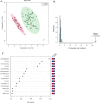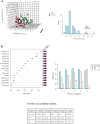A targeted metabolomics approach for sepsis-induced ARDS and its subphenotypes
- PMID: 37408042
- PMCID: PMC10320874
- DOI: 10.1186/s13054-023-04552-0
A targeted metabolomics approach for sepsis-induced ARDS and its subphenotypes
Abstract
Background: Acute respiratory distress syndrome (ARDS) is etiologically and clinically a heterogeneous disease. Its diagnostic characteristics and subtype classification, and the application of these features to treatment, have been of considerable interest. Metabolomics is becoming important for identifying ARDS biology and distinguishing its subtypes. This study aimed to identify metabolites that could distinguish sepsis-induced ARDS patients from non-ARDS controls, using a targeted metabolomics approach, and to identify whether sepsis-induced direct and sepsis-induced indirect ARDS are metabolically distinct groups, and if so, confirm their metabolites and associated pathways.
Methods: This study retrospectively analyzed 54 samples of ARDS patients from a sepsis registry that was prospectively collected from March 2011 to February 2018, along with 30 non-ARDS controls. The cohort was divided into direct and indirect ARDS. Metabolite concentrations of five analyte classes (energy metabolism, free fatty acids, amino acids, phospholipids, sphingolipids) were measured using liquid chromatography-tandem mass spectrometry and gas chromatography-mass spectrometry by targeted metabolomics.
Results: In total, 186 metabolites were detected. Among them, 102 metabolites could differentiate sepsis-induced ARDS patients from the non-ARDS controls, while 14 metabolites could discriminate sepsis-induced ARDS subphenotypes. Using partial least-squares discriminant analysis, we showed that sepsis-induced ARDS patients were metabolically distinct from the non-ARDS controls. The main distinguishing metabolites were lysophosphatidylethanolamine (lysoPE) plasmalogen, PE plasmalogens, and phosphatidylcholines (PCs). Sepsis-induced direct and indirect ARDS were also metabolically distinct subgroups, with differences in lysoPCs. Glycerophospholipid and sphingolipid metabolism were the most significant metabolic pathways involved in sepsis-induced ARDS biology and in sepsis-induced direct/indirect ARDS, respectively.
Conclusion: Our study demonstrated a marked difference in metabolic patterns between sepsis-induced ARDS patients and non-ARDS controls, and between sepsis-induced direct and indirect ARDS subpheonotypes. The identified metabolites and pathways can provide clues relevant to the diagnosis and treatment of individuals with ARDS.
Keywords: Adult; Biomarkers; Metabolomics; Pathways; Respiratory distress syndrome; Sepsis.
© 2023. The Author(s).
Conflict of interest statement
All authors report no conflict of interest.
Figures







Similar articles
-
ARDS metabolic fingerprints: characterization, benchmarking, and potential mechanistic interpretation.Am J Physiol Lung Cell Mol Physiol. 2021 Jul 1;321(1):L79-L90. doi: 10.1152/ajplung.00077.2021. Epub 2021 May 5. Am J Physiol Lung Cell Mol Physiol. 2021. PMID: 33949201 Clinical Trial.
-
Explore potential plasma biomarkers of acute respiratory distress syndrome (ARDS) using GC-MS metabolomics analysis.Clin Biochem. 2019 Apr;66:49-56. doi: 10.1016/j.clinbiochem.2019.02.009. Epub 2019 Feb 16. Clin Biochem. 2019. PMID: 30779905
-
Identifying early predictive and diagnostic biomarkers and exploring metabolic pathways for sepsis after trauma based on an untargeted metabolomics approach.Sci Rep. 2025 Apr 8;15(1):12068. doi: 10.1038/s41598-025-92631-3. Sci Rep. 2025. PMID: 40199964 Free PMC article.
-
[Research progress of vitamin metabolomics in acute respiratory distress syndrome].Zhonghua Wei Zhong Bing Ji Jiu Yi Xue. 2021 Oct;33(10):1262-1265. doi: 10.3760/cma.j.cn121430-20210508-00669. Zhonghua Wei Zhong Bing Ji Jiu Yi Xue. 2021. PMID: 34955141 Review. Chinese.
-
An NMR based panorama of the heterogeneous biology of acute respiratory distress syndrome (ARDS) from the standpoint of metabolic biomarkers.NMR Biomed. 2020 Feb;33(2):e4192. doi: 10.1002/nbm.4192. Epub 2019 Nov 16. NMR Biomed. 2020. PMID: 31733128 Review.
Cited by
-
Metabolomic stratification of shock: pathophysiological insights for personalized critical care.Ann Intensive Care. 2025 Jul 31;15(1):109. doi: 10.1186/s13613-025-01532-1. Ann Intensive Care. 2025. PMID: 40745510 Free PMC article.
-
Sequential respiratory support in septic patients undergoing continuous renal replacement therapy: A study based on MIMIC-III database.Heliyon. 2024 Mar 16;10(6):e27563. doi: 10.1016/j.heliyon.2024.e27563. eCollection 2024 Mar 30. Heliyon. 2024. PMID: 38524548 Free PMC article.
-
Efficacy and metabolomic analysis of the pneumonia compound formulation against community-acquired pneumonia: an observational controlled before-after clinical trial.BMC Infect Dis. 2025 Mar 31;25(1):441. doi: 10.1186/s12879-025-10823-8. BMC Infect Dis. 2025. PMID: 40165069 Free PMC article. Clinical Trial.
-
Application of metabolomics in acute respiratory distress syndrome: A narrative review.Sci Prog. 2025 Jul-Sep;108(3):368504251356317. doi: 10.1177/00368504251356317. Epub 2025 Jul 30. Sci Prog. 2025. PMID: 40739889 Free PMC article. Review.
-
Integrative multi-omics analysis unravels the host response landscape and reveals a serum protein panel for early prognosis prediction for ARDS.Crit Care. 2024 Jul 2;28(1):213. doi: 10.1186/s13054-024-05000-3. Crit Care. 2024. PMID: 38956604 Free PMC article.
References
-
- Villar J, Blanco J, Anon JM, Santos-Bouza A, Blanch L, Ambros A, Gandia F, Carriedo D, Mosteiro F, Basaldua S, et al. The ALIEN study: incidence and outcome of acute respiratory distress syndrome in the era of lung protective ventilation. Intensive Care Med. 2011;37(12):1932–1941. doi: 10.1007/s00134-011-2380-4. - DOI - PubMed
-
- Gajic O, Dabbagh O, Park PK, Adesanya A, Chang SY, Hou P, Anderson H, 3rd, Hoth JJ, Mikkelsen ME, Gentile NT, et al. Early identification of patients at risk of acute lung injury: evaluation of lung injury prediction score in a multicenter cohort study. Am J Respir Crit Care Med. 2011;183(4):462–470. doi: 10.1164/rccm.201004-0549OC. - DOI - PMC - PubMed
-
- Hoelz C, Negri EM, Lichtenfels AJ, Concecao GM, Barbas CS, Saldiva PH, Capelozzi VL. Morphometric differences in pulmonary lesions in primary and secondary ARDS. A preliminary study in autopsies. Pathol Res Pract. 2001;197(8):521–530. - PubMed
MeSH terms
Substances
Grants and funding
LinkOut - more resources
Full Text Sources
Other Literature Sources
Medical

